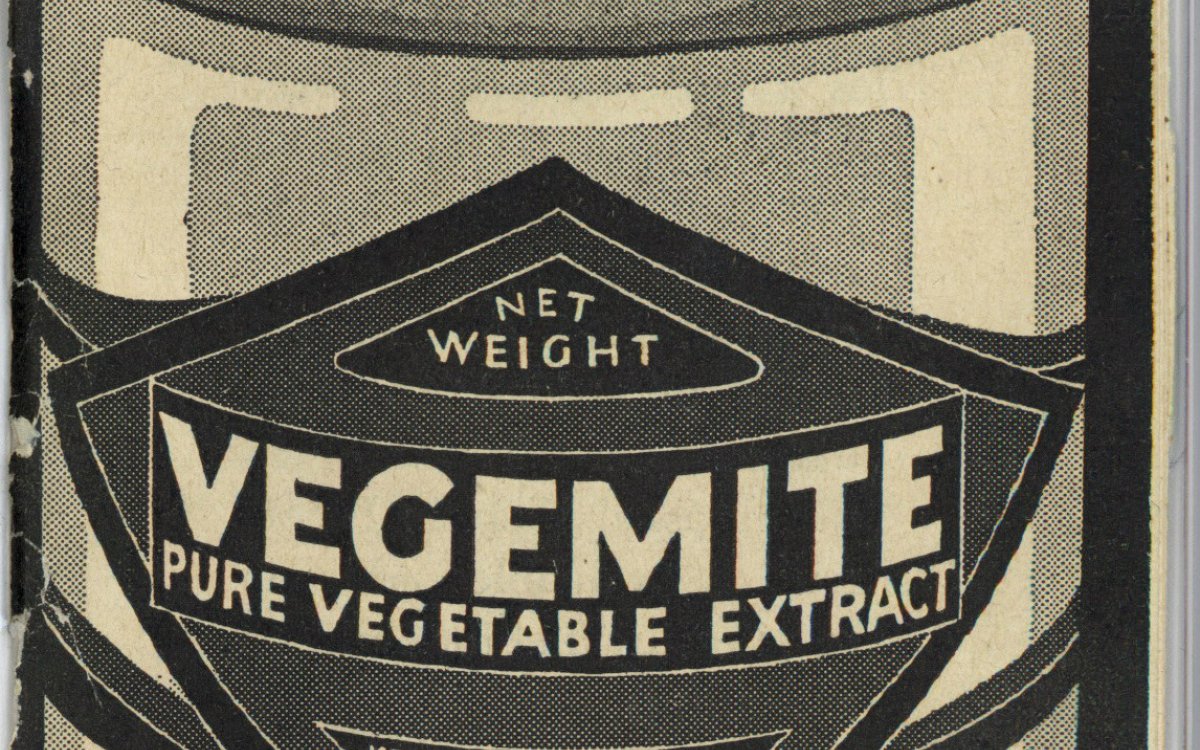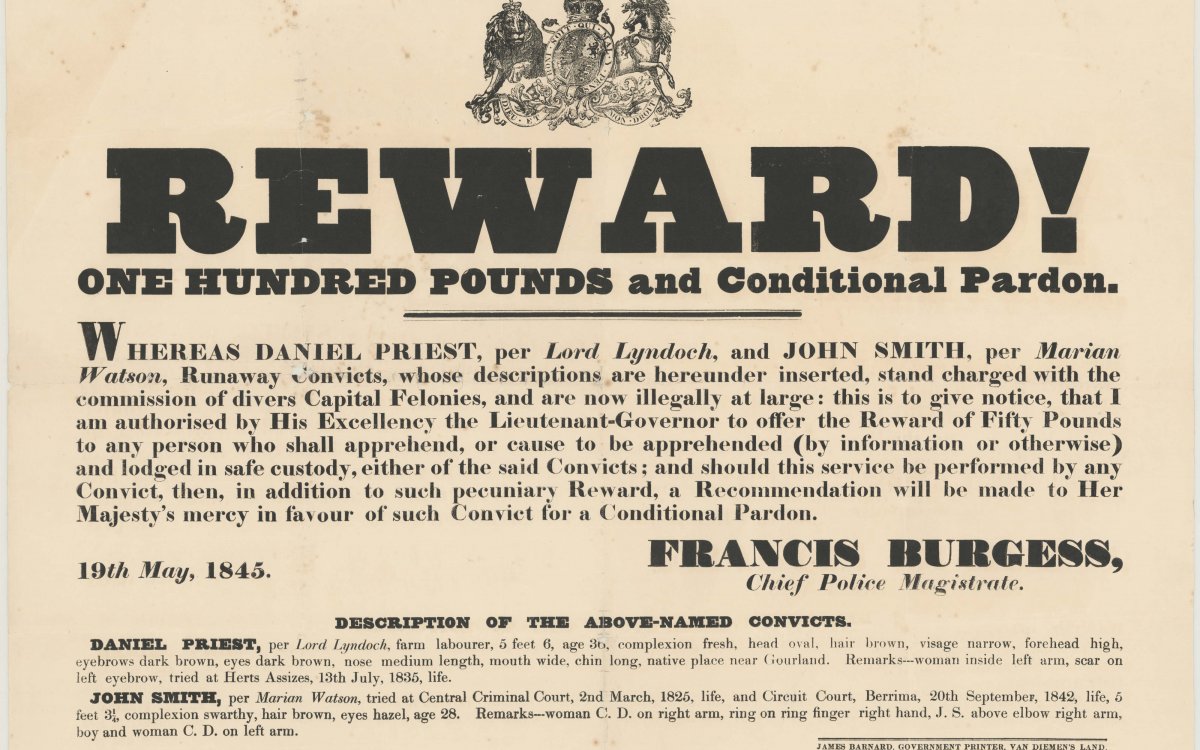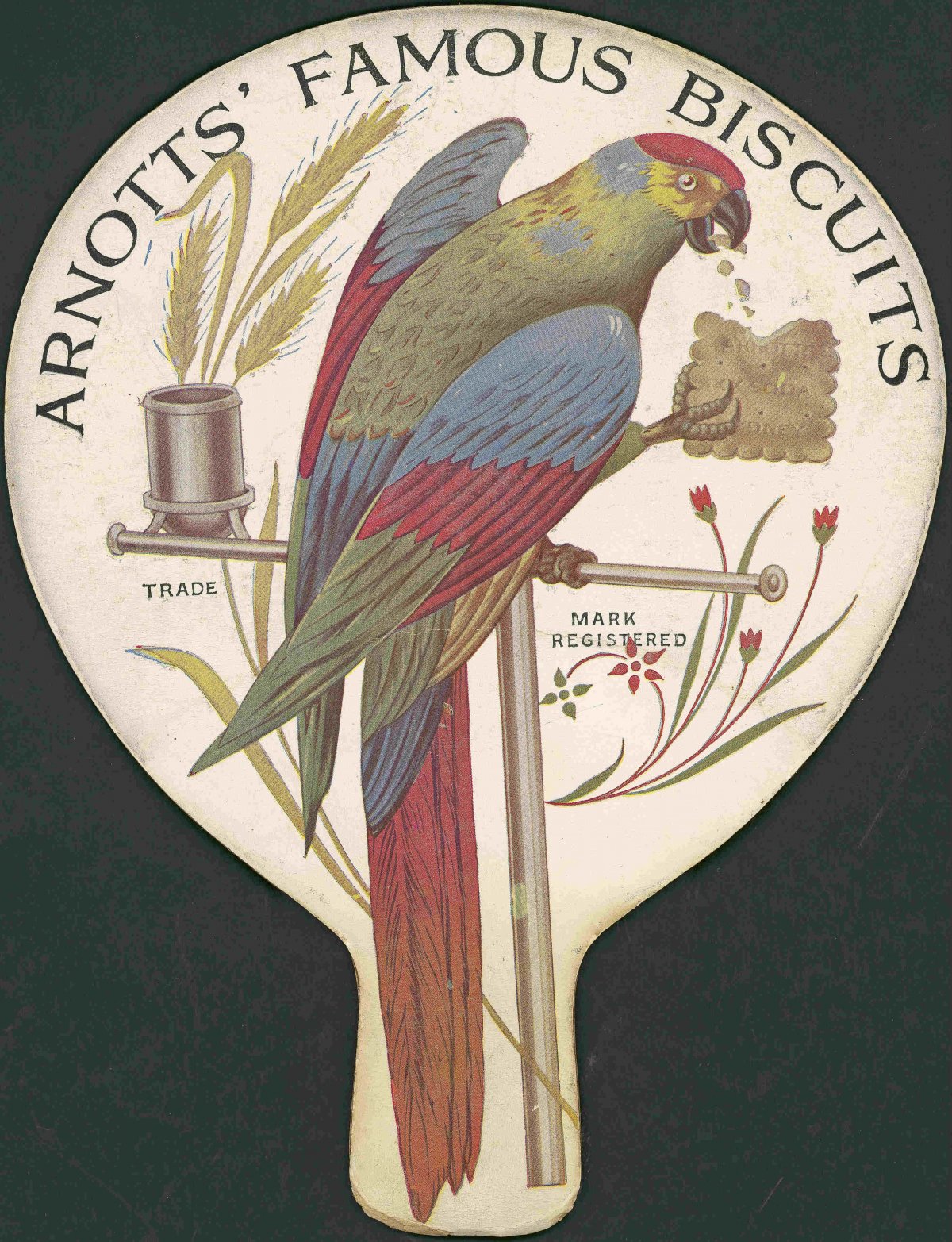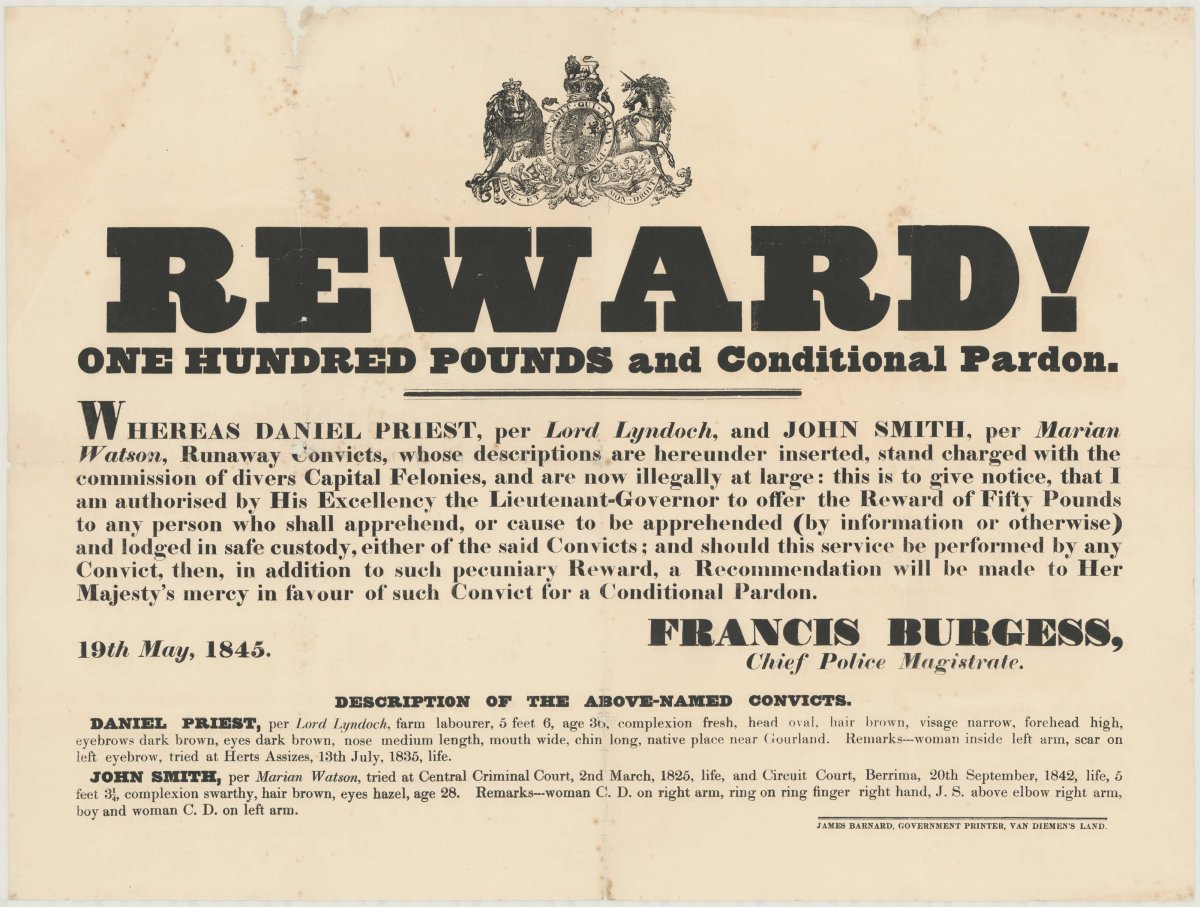This resource has been generously supported by Optus. Through the Digital Thumbprint program and Kids Helpline @ School, Optus supports digital knowledge and the positive use of technology.
Iconic Brands

[Food industry - biscuits and cakes : trade catalogues ephemera collected by the National Library of Australia]. http://nla.gov.au/nla.obj-84640628

Kraft Walker Cheese Co. (1951). Vegemite : pure vegetable extract. Melbourne : Kraft Walker Cheese Co. http://nla.gov.au/nla.obj-39597647

Lenertz, Albert Francis, 1891-1943. (1950). Aeroplane jelly song [music]. https://nla.gov.au/nla.cat-vn3885655

(1925). Billboard advertising Minties lollies inside a railway station, Melbourne, Victoria, approximately 1925. http://nla.gov.au/nla.obj-152822407
Arnotts’
Founded in Newcastle in 1865 by William Arnott and still in operation, though now foreign-owned, Arnotts’ has used many slogans over its 151-year history, but a constant has been the parrot. The story goes that William Arnott was given a Mexican parrot by a ship’s captain. His daughter-in-law, Leslie, drew it while it was sitting on a pole eating a biscuit. (The bird died in 1918.) The parrot was registered as a logo in 1888 and trademarked in 1907.
This fan is thought to date from the 1920s and 1930s. It advertises SAO biscuits, a plain cracker biscuit introduced in 1906 and an Arnotts’ bestseller, particularly early in the twentieth century.
‘Many ways with Vegemite’
Vegemite, the iconic dark-brown yeast extract high in vitamin B, came out in 1923.
This vegemite recipe book is likely the one that was advertised in The Australian Women’s Weekly between July and December 1939, targeting mothers: ‘Your Baby Needs the 3 Vital Vitamins’. The article encouraged readers to send for the recipe book.
‘I like Aeroplane Jelly, Aeroplane Jelly for me!’
The Aeroplane Jelly jingle is undoubtedly one of the most lasting and successful Australian advertising jingles. It was first played on Sydney radio station 2KY in early 1930.
This sheet music was published after 1953. We know this because its reverse advertises calorie-controlled jelly, which was introduced then. The cover features a rendering of Tommy Dawes, also known as ‘the whistling boy’, from the early television commercial. He was on Aeroplane Jelly packaging throughout much of the twentieth century.
‘It’s moments like these’
Few advertising slogans have been as successful or as long-lasting as the one for the chewable mint sweet, Minties. Invented by Australian James Steadman and sold under the SweetAcres brand, Minties came out in September 1922, was patented in 1926 and its iconic ‘It’s moments like these’ advertisements came out that same year.
This railway advertisement is from 1925 and so is missing the famous tag line, but the logo—‘Minties’—is still recognisable today.
Arnotts’
Founded in Newcastle in 1865 by William Arnott and still in operation, though now foreign-owned, Arnotts’ has used many slogans over its 151-year history, but a constant has been the parrot. The story goes that William Arnott was given a Mexican parrot by a ship’s captain. His daughter-in-law, Leslie, drew it while it was sitting on a pole eating a biscuit. (The bird died in 1918.) The parrot was registered as a logo in 1888 and trademarked in 1907.
This fan is thought to date from the 1920s and 1930s. It advertises SAO biscuits, a plain cracker biscuit introduced in 1906 and an Arnotts’ bestseller, particularly early in the twentieth century.
‘Many ways with Vegemite’
Vegemite, the iconic dark-brown yeast extract high in vitamin B, came out in 1923.
This vegemite recipe book is likely the one that was advertised in The Australian Women’s Weekly between July and December 1939, targeting mothers: ‘Your Baby Needs the 3 Vital Vitamins’. The article encouraged readers to send for the recipe book.
‘I like Aeroplane Jelly, Aeroplane Jelly for me!’
The Aeroplane Jelly jingle is undoubtedly one of the most lasting and successful Australian advertising jingles. It was first played on Sydney radio station 2KY in early 1930.
This sheet music was published after 1953. We know this because its reverse advertises calorie-controlled jelly, which was introduced then. The cover features a rendering of Tommy Dawes, also known as ‘the whistling boy’, from the early television commercial. He was on Aeroplane Jelly packaging throughout much of the twentieth century.
‘It’s moments like these’
Few advertising slogans have been as successful or as long-lasting as the one for the chewable mint sweet, Minties. Invented by Australian James Steadman and sold under the SweetAcres brand, Minties came out in September 1922, was patented in 1926 and its iconic ‘It’s moments like these’ advertisements came out that same year.
This railway advertisement is from 1925 and so is missing the famous tag line, but the logo—‘Minties’—is still recognisable today.
These advertising campaigns were for iconic Australian brands. Share the Trove lists below with the class to investigate the multimodal texts created for these campaigns in more detail.
The Sell: Australian Advertising 1790s to 1990s - Arnott's Biscuits
The Sell: Australian Advertising 1790s to 1990s - Vegemite
The Sell: Australian Advertising 1790s to 1990s - Minties
- In small groups, have students analyse these brand identities. If you have a large number of students, have them brainstorm other iconic Australian brands or campaigns that they could analyse.
- What is memorable?
- Are there any notable visual and design elements?
- Think about how the elements draw our gaze.
- Are there symbolic meanings behind some of the elements?
- What do the advertisers want us to believe about the product?
- The brands of Arnotts’, Vegemite and Minties all still exist today, although some are foreign-owned. As a class, discuss to what extent their logos and advertising campaigns have changed since the mid twentieth century. What are some reasons for these changes? What elements, if any, have remained the same? Why?
Early Ads

Hughes, George & King, Philip Gidley & Chalmers, George & Turner, Dawson & Rowe, Nicholas & Forde, Brownlow & Library and Archives Canada & National Library of Australia. (1796). For the benefit of J. Butler and W. Bryant : at the Theatre, Sydney on July 30, 1796 will be performed Jane Shore ... : after the play The Wapping landlady ... to which will be added The miraculous cure http://nla.gov.au/nla.obj-1419486

(1845). [Wanted poster for Daniel Priest and John Smith, runaway convicts.]. [Hobart?], Van Diemen's Land : James Barnard, Government Printer http://nla.gov.au/nla.obj-342218647

New South Wales. Colonial Secretary's Office & Forster, William, 1818-1882. (1863). L.4000 reward for the apprehension of John Gilbert, John O'Mealley [sic], Benjamin Hall and John Vane : whereas the above named persons are changed with... numerous and various offences... / William Forster. [Sydney : Colonial Secretary's Office] http://nla.gov.au/nla.obj-88863857
Australia’s earliest existing printed document: an advertisement
This playbill advertises an evening’s entertainment at Sydney’s first purpose-built theatre. The layout is typical of eighteenth-century London theatre playbills, and dates back to Shakespeare, a playwright that the colonists knew well. Most of the actors were literate convicts. There are collectors who collect playbills and this example had passed through several owners before being rediscovered unexpectedly in 2007 in Library and Archives Canada.
‘Wanted’ posters
Large notices with text—broadsides—were used as a means of public control and a key way to get a message across. This ‘wanted’ poster uses typography to great effect—a so-called ‘fat face’ type that was introduced in England by Robert Thorne in 1803 and that changed the language of posters. The coat of arms signifies that this poster had government authority. The language used and the size of ‘REWARD’ show that the government knew its audience—convicts—and offered not only money, but also a possibility of freedom.
The second broadside calls for the apprehension of one of Australia’s most notorious bushrangers—Ben Hall (1837–1865)—and his gang. It reserves the largest font for the Queen—V[ictoria] R[egina]. The use of multiple fonts and breaking of ‘Benjamin’ over two lines would not be considered good design practice today. Similar wording appeared in November and December 1863 in government gazettes and newspaper advertisements in south-eastern Australia. The reward rose from £2,500 to £4,000 for the four bushrangers in a matter of days. O’Meally was shot dead on 19 November 1863 by a Mr Campbell, who received 1,000 pounds, his share of the total reward.
Australia’s earliest existing printed document: an advertisement
This playbill advertises an evening’s entertainment at Sydney’s first purpose-built theatre. The layout is typical of eighteenth-century London theatre playbills, and dates back to Shakespeare, a playwright that the colonists knew well. Most of the actors were literate convicts. There are collectors who collect playbills and this example had passed through several owners before being rediscovered unexpectedly in 2007 in Library and Archives Canada.
‘Wanted’ posters
Large notices with text—broadsides—were used as a means of public control and a key way to get a message across. This ‘wanted’ poster uses typography to great effect—a so-called ‘fat face’ type that was introduced in England by Robert Thorne in 1803 and that changed the language of posters. The coat of arms signifies that this poster had government authority. The language used and the size of ‘REWARD’ show that the government knew its audience—convicts—and offered not only money, but also a possibility of freedom.
The second broadside calls for the apprehension of one of Australia’s most notorious bushrangers—Ben Hall (1837–1865)—and his gang. It reserves the largest font for the Queen—V[ictoria] R[egina]. The use of multiple fonts and breaking of ‘Benjamin’ over two lines would not be considered good design practice today. Similar wording appeared in November and December 1863 in government gazettes and newspaper advertisements in south-eastern Australia. The reward rose from £2,500 to £4,000 for the four bushrangers in a matter of days. O’Meally was shot dead on 19 November 1863 by a Mr Campbell, who received 1,000 pounds, his share of the total reward.
Handbills—also known as flyers or leaflets—are messages printed on small pieces of paper with the intention of mass distribution. By contrast, a broadside is a message or announcement printed on one side of a single (often very large) sheet of paper. They require a simple message that can be conveyed quickly to passers-by.
These advertisements—the playbill and the ‘wanted’ posters have different purposes, but they all follow accepted layout conventions that are still used today.
- Have half of the class find examples of advertisements for theatrical performances from the 1790s to the modern era. Students can use the Catalogue to search through the National Library’s PROMPT sequence of performing arts ephemera.
- What are some enduring layout features of this type of advertising?
- What information is absolutely essential to include?
- Why would the colonists who were staging the performance at the Theatre, Sydney, in 1790 attempt to recreate a London playbill?
- Have the other half of the class find examples of ‘wanted’ posters, from convict and colonial times to more modern examples. Using Trove, students could search using keywords such as ‘wanted’, ‘poster’, ‘reward’, ‘murder’, ‘bushranger’.
- What are some enduring layout features of this type of advertising?
- What information is absolutely essential to include?
- Why are some elements larger than others?
- What developments in technology have improved the effectiveness of this type of advertising?






